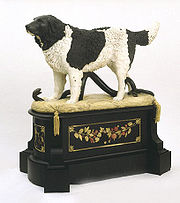
Bashaw (Matthew Cotes Wyatt)
Encyclopedia

Newfoundland (dog)
The Newfoundland is a breed of large dog. Newfoundlands can be black, brown, gray, or black and white. They were originally bred and used as a working dog for fishermen in the Dominion of Newfoundland, now part of Canada. They are known for their giant size, tremendous strength, calm dispositions,...
, sat some fifty times for his remarkable portrait. His owner, Lord Dudley and Ward
Earl of Dudley
Earl of Dudley, of Dudley Castle in the County of Stafford, is a title that has been created twice in the Peerage of the United Kingdom, both times for members of the Ward family. This family descends from Sir Humble Ward, the son of a wealthy goldsmith and jeweller to King Charles I...
, commisssioned the marble sculpture from Matthew Cotes Wyatt
Matthew Cotes Wyatt
Matthew Cotes Wyatt was a painter and sculptor and a member of the Wyatt family, who were well-known in the Victorian era as architects and sculptors.-Early life:...
(1777-1862) in 1831. The work was to have been displayed in Lord Dudley's house in Park Lane
Park Lane (road)
Park Lane is a major road in the City of Westminster, in Central London.-History:Originally a country lane running north-south along what is now the eastern boundary of Hyde Park, it became a fashionable residential address from the eighteenth century onwards, offering both views across Hyde Park...
, but he died the year before it was finished, in 1833, and Bashaw remained in the possession of the sculptor until his death in 1862. Dogs' portraits were occasionally painted during the nineteenth century, but this elaborate lifesize sculpted piece, originally set with gems is unique. In 1851 it was shown at The Great Exhibition
The Great Exhibition
The Great Exhibition of the Works of Industry of all Nations or The Great Exhibition, sometimes referred to as the Crystal Palace Exhibition in reference to the temporary structure in which it was held, was an international exhibition that took place in Hyde Park, London, from 1 May to 15 October...
, where it was entitled The Faithful Friend to Man Trampling Underfoot his Most Insidious Enemy, in reference to the bronze cobra
Cobra
Cobra is a venomous snake belonging to the family Elapidae. However, not all snakes commonly referred to as cobras are of the same genus, or even of the same family. The name is short for cobra capo or capa Snake, which is Portuguese for "snake with hood", or "hood-snake"...
beneath the dog's feet. The placid expression of the dog, and the elegant cushion on which he stands, contrast with the coiled energy of the snake.
The sculpture remained unsold at the sale of Wyatt's effects after his death in 1862, and fell into the possession of his son, James, who put it up for sale at Christie's
Christie's
Christie's is an art business and a fine arts auction house.- History :The official company literature states that founder James Christie conducted the first sale in London, England, on 5 December 1766, and the earliest auction catalogue the company retains is from December 1766...
in 1887. It was unsold, but subsequently passed into the possession of John Corbett of Impney Hall, Droitwitch, Worcestershire, and was then sold to Edward Stevens of Prescott House, Stourbridge, in 1906. In 1957 the sculpture was sold again; it was bought by the Victoria and Albert Museum for £200 in 1960.
Matthew Cotes Wyatt (1777-1862) was the son of the architect James Wyatt , and was a painter and designer as well as a sculptor. The elaborate base made for Bashaw reflects his abilities in the field of decorative arts. In 1834 Wyatt held an exhibition of his works with Bashaw as the centrepiece. It was described in the catalogue as 'the most elaborate [portrayal] of a quadruped ever produced by ancient or modern art'.
The sculpture is made of coloured marbles and hardstones. The dog's eyes are topaz, sardonyx and black lava, while the snake is bronze with ruby eyes. The cushions are of gilt bronze.

